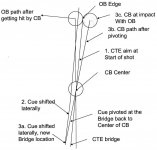This is all you need to know. Everything else is bullshit. Make the training aid and have at it.
http://books.google.com/books?id=dK...v=onepage&q=the arrow babe cranfield&f=false
You all look silly still discussing this stupid way to aim.
Short of the Arrow...(which is uneeded BTW) this is exactly the beginning of how I aim.....(This is the Center to Center Method)
Now that I think about...I am not even sure it should be called a Ghost Ball system...The reality is that I never envision a ghost ball of any kind...I am only looking for the spot on the cloth that is the exact center of where the Ghost Ball would be...That is the extent of the connection...
That is only the beginning however....I (standing behind the CB now) extend a line from the center CB (to the center GB) and past to the OB...I look at where the line contacts the OB and in combination what is the overlap....aka...which of the 3-line aim lines am I on......sometimes it is not dead on one of the 3 line aims...but what I have found is that it is always very close and only favors to one side or the other (of the 3-lines)...when that happens I just do what it tells me and "favor" to that side of the 3-line contact......I feel that this "makes up" for the minute differences in some of GetMeThere's graph that breaks it down to within "cheating the pocket" differences.
The beauty of the system is that "everything" is based off of center CB as a starting point...not pivots are necessary and there is no need to remember to change pivot lengths based on shot length...
That honsetly is the main draw back that I see with CTE...the pivoting really thows me off and moreso thows off my foot/body/cue alingment....
With the "center to center conversion to 3-line" system...aka...CTCC3L method...as your standing behind the CB and found your aim line...the back foot ends up on that line so you can't "lose" the line...and it does not really matter anyway...because you have also already converted to one of the 3-line shots....(perhaps with a "favor" to one side)
"Yeah..but how do you find center CB without the Arrow"....Glad you asked.....I have done it for so long that I just know where it is....it is pretty much habit....If I need some re-assurance that I have the right spot......and I don't have my handy arrow....I will stand behind the OB in direct line with where I want the OB to go...(may not be a corner pocket)
I will take my cue tip and place it directly behind of the OB along the intended line...I will drag the tip back from the OB while looking at the tip reflection on the OB....as the reflection moves up to the halfway point...My actual tip will be where the center of the GB would be....Keeping the tip in place if I have to I can then swing the butt of the cue around so it is directly over the CB.....in that instant I have the center to center aim point.....and a conversion to one of the 3-line shots....I could now go take a drink walk around the table or whatever if I had to...when I come back I already know which 3-line aim point I will be shooting at.
"Yeah...but how do you know when the reflection is halfway?" .....well I am glad you asked....if you look at the OB, you will notice that the bottom half of the ball is shaded...the top has direct light...Most probably never realize that is the case...but once you look close you will see what I meam....As I draw the cue back from the OB...and the tip moves up...just before it reaches the point where the shade turnes to light....that is halfway.....To check yourself to see if you "see it right" you can mark what you think the the correct "center" and then place a ball in that spot......then adjust accordingly...after you do it a couple times...you will find it real simple to find the center mark.
For some...CTE is the better method....I get that and am fine with it...but for those that want to use a 3-line method....have a hard time picking the right line....and have a hard time with the pivoting....this may be the alternative method.
From what I have read/seen....experimented with...the CTE pivot ends you in the exact same aims....However...the only way I know how to use CTE is into the corner pockets...CTE does not get me to the side pockets...or points on rails....
